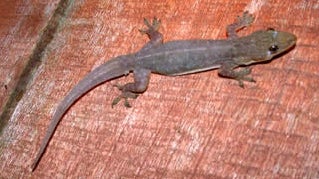SCIENTIFIC NAME:
Hemidactylus garnotii
SOME OTHER SOUTHEASTERN AMERICAN GECKOS:
Tokay Gecko (largest species 10-13 inches in length), Florida Reef Gecko, Ocellated Gecko, Ashy Gecko, Yellow-head Gecko, Moorish Gecko, Bibron’s Gecko. There are at least 7 introduced species mainly found in Florida. Other common names for the Indo-Pacific Gecko are Garnot’s House Gecko and Fox Gecko.
STATUS:
Exotic
DESCRIPTION:
Indo-Pacific gecko’s range from 4-5.5 inches in length. Unlike lizards, they lack eyelids, have vertical pupils, and toe pads. They have smooth skin, except for their flattened tail which has a row of spiny scales on the lateral edges. Their color is generally a dull dark gray to brownish with light markings and they can change to a translucent color at night. Their belly is yellow to orange in color.
DISTRIBUTION:
The Indo-Pacific gecko’s native range is believed to be Southeast Asia. They have been introduced to many tropical areas including parts of India, Polynesia, Philippines, Australia, Hawaii, and now Florida, Georgia, and Alabama. In Alabama, sporadic populations, especially in the southern half of state.
HABITAT:
In the United States the Indo-Pacific gecko generally inhabit areas associated with human development, urban and suburban areas alike. They can be commonly found in warehouses, shelters, and other man made structures. They also can be found in the sand pine scrub and mangrove forest of Florida. During the day they hide under tree bark, rocks, cracks and crevices of buildings, fences and bridges
FEEDING HABITS:
Indo-Pacific geckos prey on a wide variety of spiders, insects, and other invertebrates. They can be found on walls and other structures at night waiting to grab insects attracted by lights.
LIFE HISTORY AND ECOLOGY:
Indo-Pacific geckos are nocturnal (active at night). Unlike most lizards, geckos vocalize with other geckos and may even use sounds to ward off potential predators with faint squeaking and barking sounds. Geckos are also unique in that they have unisexual mode of reproduction. All geckos are females, reproducing by parthenogenesis – a process in which unfertilized eggs develop and hatch without fertilization. “Courtship” may be necessary to stimulate egg development. Eggs are commonly laid in pairs in moist soils, under tree bark, and in crevices.
REFERENCES:
Conant, Roger and Collins, Joseph T. 1998. Peterson Field Guides, Reptiles and Amphibians. Houghton Mifflin Company, NY., NY. 616 pp.
National Audubon Society. 1979. Field Guide to Reptiles and Amphibians, North America. Chanticleer Press, Inc. 743 pp.
AUTHOR:
Daniel Toole, Wildlife Biologist, Alabama Division of Wildlife and Freshwater Fisheries






